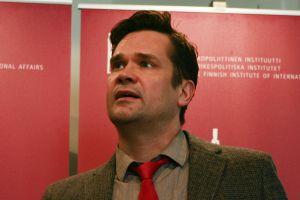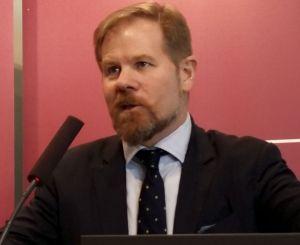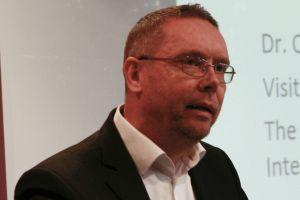From Syria to Somalia, from Libya to Indonesia, from Afghanistan and Pakistan to Yemen, Islamic militancy is more widespread and threatening than ever. The counterterrorism policies and strategies that have been implemented in the past decade have, to a degree, failed. The rise of Daesh is an example of the enormous challenges. While the end of the Caliphate is looming, it is unlikely that the virulent phenomenon of Islamic terrorism will disappear. Al Qaeda and its factions and subsidiaries proliferate worldwide and remain potent. This seminar addresses the state of play of counterterrorism policies and strategies against the backdrop of Islamic militancy. In what direction will Islamic terrorism most likely develop? What are the lessons from counterterrorism policies and strategies implemented in the recent past?
Chair:
Mika Aaltola, Program Director, the Finnish Institute of International Affairs

Speaker:
David Kilcullen, Senior Fellow in the Future of War Program, New America Foundation

Comments:
Olli Ruohomäki, Senior Research Fellow, the Finnish Institute of International Affairs

SUMMARY
In his opening remarks, Mika Aaltola, the director of the Global Security research programme, welcomed the keynote speaker David Kilcullen, a senior fellow in the Future of War Program at New America Foundation. Dr. Kilcullen is one of the foremost experts focusing on counterinsurgency and guerrilla warfare. He has served as a Chief Strategist in the Office of the Coordinator for Counterterrorism at the U.S. State Department from 2005 to 2006, and as a senior counterinsurgency advisor for General David Petraeus in 2007 and 2008. Dr. Olli Ruohomäki, a senior research fellow at FIIA, gave his comments on the topic before discussion and questions from the audience.
Where does ISIS come from?
Islamic militancy has gained a global foothold and is more threatening than ever, despite the fact that the ISIS “caliphate” is likely to see its end in the near future. Dr. Kilcullen approached the topic by introducing the preconditions for the rise of the Islamic State, according to him the key factor being the Iraq war and the untimely exit of the U.S. troops from Iraq in 2011. External factors, such as the Arab Spring and the Syrian civil war also played a role in creating a fertile ground for a group like ISIS to form. A key individual in the process was Abu Mus’ab Al-Zarqawi, a Jordanian who joined the mujahideen in Afghanistan in the late 1980s, also meeting Osama bin Laden during his time there. Dr. Kilcullen remarked that Zarqawi was never a member of Al Qaida (AQ), and even after he set up a training camp in Afghanistan, there was no direct command from the AQ leadership. According to Dr. Kilcullen, this is important to notice since the U.S. tends to find this link crucial. Finally, Zarqawi’s key role was realized in 2003 when the U.S. invasion began. He was well organized and ready to lead the insurgency force.
In Dr. Kilcullen’s view, the U.S. was not able to exercise an effective occupation policy and was unable to stabilize the country. On the other hand, Zarqawi’s group turned out to be extremely brutal and in that sense distinctive from the other groups that mainly focused on attacking military targets. In addition, Zarqawi’s strategy was different from that of AQ: his plan was to inflame sectarian chaos and a Shi’a–Sunni civil war in order to rise to power with his group. AQ on the other hand did not want to see a sectarian conflict taking place and accused Zarqawi of ‘’giving terrorism a bad name’’, since the aim of AQ was to embrace the broader front, not to focus on fighting the Shi’a. Zarqawi’s plan was successful until his death in 2006. Abu Ayyub al-Masri and Abu Omar al-Baghdadi succeeded him as the leaders of the Islamic State of Iraq (also known as Al Qaida in Iraq). After the Sunni tribes agreed to fight the group in 2007, a decline in killings, violence and AQ activity was perceived.
When it comes to the withdrawal of the U.S. troops from Iraq, Dr. Kilcullen considers it untimely and premature. After the failure of the Arab Spring and the Syrian civil war, people turned back to the jihad way of fighting, the IS benefitting from the situation in Syria. Bashar al-Asad for his part, while presenting himself as secular and antiterrorist, released jihadi prisoners linked to AQ. All these developments provided an easy operating environment for ISIS, who finally was put on the map after capturing Mosul in 2014.
The organization and its operations
The second theme Dr. Kilcullen addressed was the organization and operation of ISIS. According to him, there is the top-level caliphate, a central state-like entity, organized in Syria and Iraq. They possess the will to operate like a state and have built up state-like institutions in order to operate accordingly. However, this structure was short-lived and is currently squeezed into a small enclave in west Mosul.
On the second level, there are the recruits, who started to flow to Syria since no previous combat experience or knowledge of Islam was required. The organization provided the training, and those recruits who were not suitable for military operations were channeled to other duties. However, the driving force for global influence is the organization’s propaganda machine with strong online and media presence, being vital for the recruitment process. Additionally, there is a third level in the organization: what Dr. Kilcullen calls an ‘’internationale’’. This layer consists mainly of a) self-radicalized individuals, who actively search propaganda and information online in chatrooms and websites, b) remotely radicalized individuals who are characteristically potential recruits for any other types of groups, not only jihadi groups. Kilcullen describes these members of the ‘’internationale’’ as generally more purist in their religious views than the top-level members of the organization, since the leadership is usually more focused on gaining personal power. According to Dr. Kilcullen, typically this ‘’internationale’’ is potentially appealing to converts and 2nd or 3rd generation immigrants, who have contacts to their origins and the language ability.
What happens after Mosul and Raqqa?
Concerning the current situation, especially in Western Europe, Kilcullen considers that radicalization and the presence of radicalized individuals with strong military experience pose a real threat. According to him, there is a chance for a full-scale insurgency in Western Europe due to the above-mentioned conditions combined with refugee flows.
Dr. Kilcullen also discussed the future prospects after Mosul and Raqqa. According to him, there will be an exodus of survivors to other parts of Syria and Iraq, and the regional effects will probably lead to the destabilization of Lebanon and increased violence. The fall of the caliphate will likely accelerate the threat of terrorism, due to the attempts to compensate territorial loss. He also believes that the most threatening group in the post-caliphate era will be the AQ affiliate Hay’at Tahrir Al-Sham (HTS), since it is probably the most capable group militarily and has a better approach to the population, making HTS the biggest player after ISIS. In general, the era after the caliphate is likely to see regional destabilization with growing Iranian (and its allies’ such as Hezbollah’s) influence. There will be a mass of refugees and among them foreign fighters returning home. In terms of security, low-tech attacks are to be expected and guerrilla-like operations and units that look less like terrorists might emerge.
According to Dr. Kilcullen, mass surveillance in the prevention of terrorism will not be able to prevent attacks, but rather damages civil liberties and accelerates the breakdown of social cohesion by making people more suspicious towards other ethnic groups. Instead, he calls for preventive actions towards radicalized individuals, efficient sharing of information and enhanced police cooperation. Finally, he reminds that ISIS is not the only one or even the most dangerous of these types of groups, and that there are other, non-Islamic groups capable of terrorist activities. However, the absolute volume of terrorism is increasing.
After the presentation, Dr. Olli Ruohomäki provided some key insights into the topic. According to him, Islamic militancy is now unfolding in Europe and the situation in regions like the Middle East, South Asia, Sahel and Somalia provides a fertile ground for violent jihadists. The current trend is characterized by technological development in communications, recruitment, logistics etc. The stakes are also raised for a high-impact, low-likelihood WMD (weapons of mass destruction) scenario. Dr. Ruohomäki noted that the lack of social movement based on citizenship instead of religion in the Middle East is a big challenge.
After the presentations by Dr. Kilcullen and Dr. Ruohomäki, the discussion revolved around questions about the financing of terrorist groups, the effect of targeted killings in counterinsurgency operations, and the role of youth in the promotion and maintenance of peace and security as outlined in the UN Resolution 2250.
